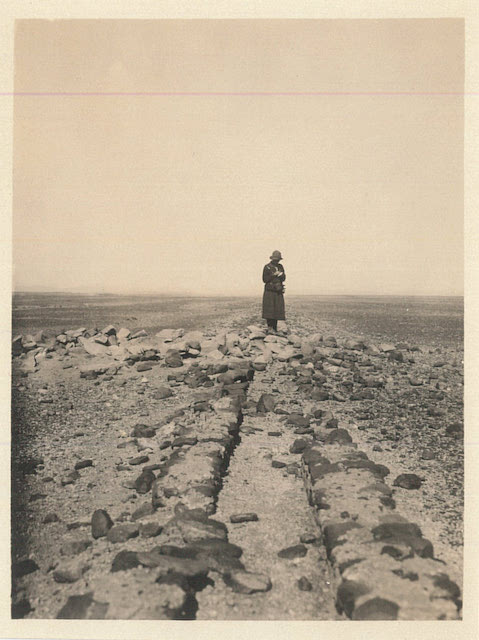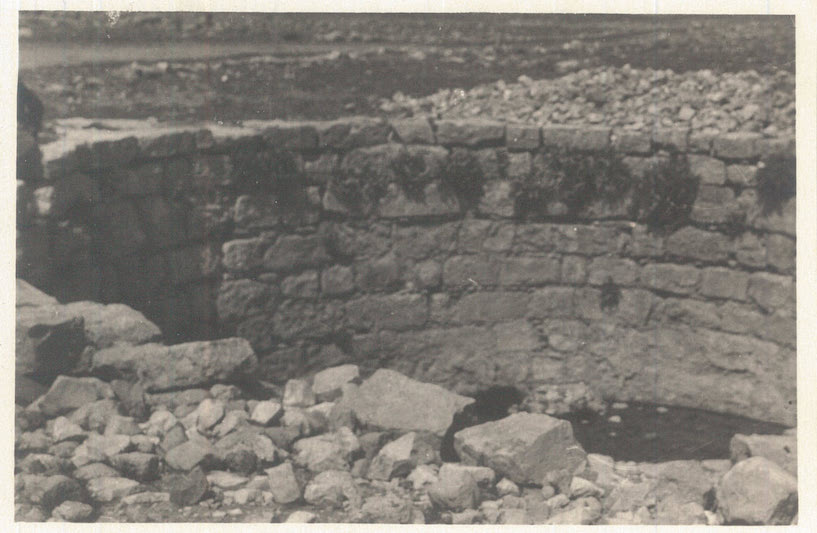|
[by Agnes Conway] After calling on the Governor of Ma’an [Khalaf Bey Atell] and Mr Strange, (Intelligence Officer to the Air Force) Mr Horsfield went to Ain Musa with one ton truck of luggage; met his 6 men who had ridden over from Jerash and sent them down to Petra to start preparing the Camp. He came back to Ma’an for the night.
Reference: Conway, A. 1929 (transcribed by A. Thornton). Petra Exploration Fund Diary. "Business Papers to be Kept", Horsfield Collection Box 8, UCL Institute of Archaeology, 21 March: 1.
[probably by Agnes Conway] Dr. Nielsen and A.E.C. left early, arriving at Petra for lunch, and had to put up at [Thomas] Cook’s Camp, our own not being ready. The Circassians from Jerash and local Arabs worked hard all day, under Mr. Horsfield’s direction, clearing out caves and building an oven. Mr Horsfield, Dr. Nielsen and A.E.C. climbed the mounds of the Roman city to see the points at which Mr H. had decided the dig should be begun. Dr. N. & A.E.C. photographed and examined the well at El Basta on the way down, which seems to be Roman and is very large and well-built. Reference: [unsigned, but probably Conway, A.] 1929 (transcribed by A. Thornton). Petra Exploration Fund Diary. "Business Papers to be Kept", Horsfield Collection Box 8, UCL Institute of Archaeology, 23 March: 3.
[By George Horsfield and probably Agnes Conway]
G. H. Thirty men arrived to work – took on 25 and started to dig again and some progress was made. The pottery is more perfect, but the ordinary Graeco Roman type-lamps and various small pots, finer fragments of red pottery and 2 pieces of glass. Picked up various fragments of thin red painted pottery, a base and part of a rim – all on the surface and in different parts of the S. side of the site. Examined the graves found in Wadi Turkomaniya [sic] and made notes in last part of the morning – doubtful as to their antiquity. In afternoon spent some time on dig – it was uninteresting. The top of the Scarp has appeared on the left hand side – so that now the rock surface is appearing across the whole width of the cut. Pottery is scarce. Examined the Nabataean wall from El Habis as far as the dig, and noted it all. There is a grave yard at the El Habis end which contains graves on the surface of the same type as those in the Turkamaniya Wadi – presumably Christian – many are orientated E & W. Money is running short – more is to be obtained – the problem is how? Mahmud is doubtful about riding in, as it takes a long time and an equally long time to return. Took on a scullion (Ali) and seems to have satisfied the cook’s wants for the moment. He has quarrelled with the Circassians and removed to the kitchen to sleep. We now have 3 Arabs as servants, Deifullah the night watchman and general go-between – Huaymil, wood and water fetcher and the scullion. We seem more settled down, but I am constantly worried by idiotic domestic details which require settling, but it is often difficult to make the necessary politic decision, so that the matter is arranged and no one is disgruntled. Dr. Canaan continued his long walks, picking up place-names, and found two High Places on Al Qantara. Dr. Nielsen went to El Ma’aisera No III sanctuary and was greatly impressed. A.E.C. visited the circle on the mount with the American party, who thought the masonry either very early or Byzantine, and probably the former. After leaving Colonel Armstrong at Sextus Florentinus, she explored the N.W. wall beyond, finding Dalman’s Sanctuaries under el Hubta, which seemed to her to belong to a Hadrianic suburb. She climbed the S. peak of El Habis in the afternoon to see Dolman’s [sic] Sanctuary I, which seemed to bear no signs of cult but was inexplicable. (Certainly a quarry). Reference: Horsfield, G. [and probably Conway, A] 1929 (transcribed by A. Thornton). Petra Exploration Fund Diary. "Business Papers to be Kept", Horsfield Collection Box 8, UCL Institute of Archaeology, 31 March: 17-18. [By George Horsfield and Agnes Conway]
Visited dig first thing. Have decided to abandon it, as it is impossible to find anything further. Several wine jar handles inscribed turned up; also part of a small polished black lamp which seems to be the prototype of the inexplicable ugly one produced locally. Found another tomb exactly the same as before, but opened it without allowing much earth to enter. The corpse lay straight on its back with hands crossed on stomach; very crumbly; bones and all fell in bits when disturbed. No objects. Moved the workmen to “Caliph” to dig further into this mound from which some fairly good fragments turned up. Found nothing on going deeper in – a mass of building rubbish lime and red sand with certain streaks of wood ash. This was followed up and finally abandoned. Paid off 30 workmen. The Circassians have got up a separate mess with Ali as cook, which it is hoped will prove more satisfactory. Dr. Tewfik Canaan left us to-day, to our regret. He came as a stranger to all of us – but our nearer acquaintance with him proved his worth. He set an excellent example by his energy, cheeriness and resource. As a friend he left us. He doctored all and sundry, making friends with all with whom he came in contact. A.E.C. went to see High Places with Dr Nielsen in the Siyagh, and then to measure the large house found two days ago opposite the Theatre. There, in some mysterious manner, she lost Dr Canaan’s watch! She went straight up the Wady bed of the Ma’aisera el Gharbiyah, from the Turkamaniya to the wall at the top, in the afternoon noting all the silted up caves in the Wady bed, and higher up the banks, of which there are a great many. Facaded tombs do not begin till very high up, and end with a large clump of them right at the top. Then there is a building with sides like a tomb and the proportions of its neighbours, but open, front and back, with a platform on the Wady side. A large tomb at the back, of the “Serai” type, still has a grave niche, filled with large stones to the very top, though the bottom row has been removed. She came back over the highest top of the ridge between the Gharbiyah and the Wady Marris Hamdan and found quarrying on the sky-line. The water channel from the top flows into the cistern behind Kennedy’s Stibadium to Brunnow 559. Reference:Horsfield, G. [and Conway, A.] 1929 (transcribed by A. Thornton). Petra Exploration Fund Diary. "Business Papers to be Kept", Horsfield Collection Box 8, UCL Institute of Archaeology, 18 April: 42-43. |
Categories
All
Archives |


 RSS Feed
RSS Feed